


Therefore, users must add the Debian multimedia repository to install the codex by editing the sources.list file that contains the list of repositories the APT uses.įollow these steps to install FFmpeg using the multimedia repository: Next, install FFmpeg by adding the command below:įFmpeg is unavailable in the official Debian 8 or older repository.Update the package list and system by running both commands consecutively:.Open the Terminal and log in via a root user.Here’s how to install FFmpeg using the default repository: The former method serves Debian 9 and newer versions, while the latter applies to Debian 8 and older versions. There are two ways to install FFmpeg on Debian – via the default and multimedia repositories. Sudo apt install ffmpeg Installing FFmpeg on Debian Insert the command below to install the FFmpeg application:.Update the system and packages installed by running both commands consecutively:.Open the Terminal and access it via a root user.Next, install FFmpeg by typing in the command below:įollow these steps to install FFmpeg via the default repository:.Sudo apt-get update sudo apt-get dist-upgrade After the PPA is installed on the system, update the repository by running these commands consecutively:.Sudo add-apt-repository ppa:mc3man/trusty-media Once done, add mc3man PPA by adding the following command:.Sudo apt-get install software-properties-common This will allow you to manage the repositories you install the application from: Install the software-properties-common package.Open the Terminal and log in as a root user.Here’s how to install FFmpeg via the PPA:

However, the installation must be done via the default repository if your machine runs Ubuntu 20.04 or 22.04. The former contains a collection of software managed by the Ubuntu community and works best on Ubuntu 18.04 and older versions. There are two methods to install FFmpeg on Ubuntu – via the Personal Package Archives (PPA) and the default repository. In this section, we will explain how to set up FFmpeg on popular Linux distributions like Ubuntu, Debian, CentOS, Fedora, and RHEL. Installing FFmpeg on CentOS, Fedora, and RHEL.


 0 kommentar(er)
0 kommentar(er)
